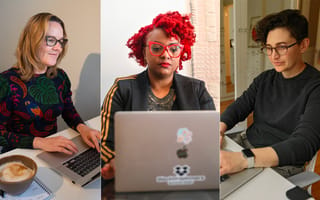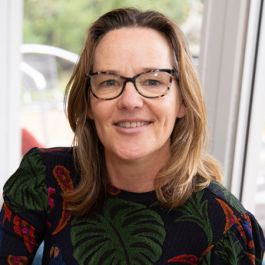“Will this make it easier for my son to share home videos?”
“Can you help me with this new feature?”
“Oh, you work at Dropbox?”
These aren’t questions Rachel Wolan received over email, at a tech mixer or through a customer support channel. They were all asked by her family members once they learned she had accepted a position at Dropbox.
“One of the things I love about working at Dropbox is that everyone is our customer,” Vice President and General Manager of Dropbox Core Rachel Wolan said. “I can describe what I do to my mom, dad and grandma, and they all understand it. That’s an amazing achievement for me in my career.”
With over 700 million users, Dropbox has long been a go-to platform for people to upload, organize and share content. For the employees behind the tech, that means they don’t struggle to understand how users interact with their features; often, they themselves are the users. According to Wolan, this makes working at Dropbox feel more accessible, and the results of her work more tangible.
“It’s such an interesting time to be at the company because we’re asking what kind of impact we want to leave on the world,” Wolan said. “Dropbox is a place where you can make a positive impact on millions of people.”
According to Wolan, that positive impact doesn’t begin with Dropbox products. It begins with its people.
“This company invests in its employees because, at the end of the day, our products are a product of our people,” Wolan said. “We have to focus on creating a great work-life balance, and an environment where people can thrive.”
Dropbox bets that when people feel both challenged and supported, they do their best work. And as talented as the team is, the ambitious roadmap ahead necessitates that employees have the space and resources required to solve complex new challenges, like designing screen-share features and video-editing tools. To make that roadmap a reality, employees are given cutting-edge tech stacks, fresh opportunities to embrace challenges, plenty of recognition and the flexibility to pursue new interests.
To learn more about the culture powering Dropbox’s success, Built In connected with Wolan and her peers, Head of Quality Engineering Nicole Barton and Director of Engineering in Core Experience Susanne Kaufmann. Together, they illustrated the support systems and emphasis on inclusion that are setting Dropbox and its people up for a new era of sharing.

What attracted you to Dropbox?
Wolan: Previously, I’d mostly worked on enterprise products, which are typically very expensive products for a handful of customers. The beauty of Dropbox is that you are building a product for millions of people to use every day. The company is focused on delivering a utility for our customers and delivering a product where there are no ads.
Customers love the product and use it to preserve everything from priceless family memories to keeping their tax documents in order to share content with their clients. It’s used interchangeably between their personal and work lives. I joined Dropbox during the pandemic, when I was experiencing the challenges of remote work. I thought it would be an amazing experience to work on products that I use.
Kaufmann: I’m a boomerang employee at Dropbox. While I was away, I spent time thinking about what the most important things to me are at work. Throughout my career, it’s always been the people I work with, the problems that need to be solved, and the impact I can have. Of the places I have worked, Dropbox has always been the place that exemplified everything that’s important to me. Coming back to the company was genuinely heartwarming, and there were so many people who welcomed me back.
What’s it like working on your team?
Barton: It’s important to me that my team has the space to do their best work. That can come in a lot of forms, but I like to focus on understanding their professional goals. That gives me insight into their motivations and how they work. In some instances, understanding their goals can mean helping them change careers: I’m currently coaching one of my engineers to become a developer, and another who wants to become a product manager. Figuring out how to balance the business needs with the needs of employees is where I like to play, because both are equally important. The more we learn about each other, the more we can be there for each other as colleagues. It also makes communication easier, which means work gets easier.
Kaufmann: In my experience, the highest-performing teams feel empowered to explore, ask questions and take risks while also being given room to stay connected. Employees should have the ability to be curious, reflective and trust their managers.
The culture I try to model is one where managers hold teams accountable and provide guardrails and encouragement. That way, your team knows what’s expected and knows what the response will be when they do well, and what the response will be when there are hiccups — because nothing is ever perfect. I believe in a no-blame, no-fear environment where everyone has the opportunity to grow and shine, and bring their best self to work.
Virtual First. People First.

Speaking of fostering a supportive environment, can you speak to Dropbox’s DEI work?
Barton: One of the reasons I joined Dropbox was because it had a very mature DEI department, as well as a human resources business partnership department. Those things are important to me, especially as a Black woman in engineering. I wanted to make sure that the company culture would support me.
I have two beautiful nieces who are extremely smart and curious, and they might go into tech someday. They’re my motivation for making this industry more welcoming to folks that come from different backgrounds, because this is a space that’s big enough for all of us. Dropbox allows me to use my voice and get involved in interviews to ensure we’re doing our best to remove bias and calibration sessions that advocate for diversity in promotions. I try to lean into my inclusive muscles to make sure we’re having well-rounded conversations, that we have the right people in the room, and that everyone feels heard.
Wolan: I’m the executive sponsor of PrideBox, which is the LGBTQ community at Dropbox, and am a co-lead of our women’s ERG. I’ve gotten to know a lot of people outside my day-to-day work, and have gotten to learn about different issues impacting our employees, which has been a fruitful and amazing experience so far. One of the most thrilling things about my current role is that I get to impact so many women in engineering, product management and design. I help them see different possibilities for themselves and their careers — that’s been so rewarding.
DEI brings a diversity of thought into the workplace. That’s my fundamental belief, and why I think it’s so important to promote diversity and inclusion at Dropbox and everywhere else I’ve worked. It’s something I think about a lot, and every day look to see how we can improve and create more momentum.
Kaufmann: I’m a mentor in our DEI sponsorship program for women and people from underrepresented groups. This is a fantastic program that helps people write self-reviews, and helps managers write the best descriptions of their team members’ work. This program allows every employee to get the best representation possible during performance reviews and promotion cycles. For women and minorities, sometimes it’s hard getting this kind of support. This program helps underrepresented talent learn to represent themselves well, and to be proud of their work. I want to continue doing this forever!

What benefits does Dropbox provide its employees? How do these benefits help you, inside and out of work?
Kaufmann: The benefits at Dropbox are fantastic. With the shift to Virtual First, we rolled out stipends where employees can spend an amount of money each quarter on items they chose for their professional and personal lives. Personally, I bought a standing desk for my home office and put money toward buying an electric bike.
For professional growth, I have benefitted from coaching experiences at Dropbox. The company has been so helpful in broadening my own perspectives and seeing myself from a leader’s perspective. Coaching opportunities helped me understand that my intuition is good, and I’m thankful for that.
Barton: Dropbox does a great job of allowing people space and giving people paid time off. We have one day a month where the whole company is off so we don’t have tasks that have been piling up when we’re out. We also have unlimited PTO, which is a benefit I make use of and encourage my team to as well. The company also matches donations, which was powerful during the height of the Black Lives Matter protests. To be able to donate to meaningful organizations and have the company match that meant a lot to me and my community.
The company also offers family planning benefits. I’m pursuing a non-traditional family, and have been looking into what Dropbox offers around adoption, foster care, egg freezing and more. I’m grateful to take advantage of those benefits as I figure out how I will have my own family in the future.
If you can envision it, build it.
What are you most excited to accomplish with your team in 2022?
Barton: The future of Dropbox is bright. I was chatting with one of our leaders a few weeks ago, and he was telling me about all of the investments we’re making in front-end technology. Dropbox has historically been known as the file-sync-and-share, back-end infrastructure platform, a space we’re still dominating. But we’re looking at our front end now, and recruiting heavily on that side because now that more people are working remotely, our users need more ways to efficiently share content.
At the end of the day, working from home will be a permanent thing for most people, similar to how it is at Dropbox. We’re investing heavily in meeting our users where they are, which is in their homes. A lot of our focus is on creating products, innovating in our infrastructure layer and continuing to build on our company’s legacy.
Wolan: When Dropbox started, we were fixing the problem of making files available in the cloud. It was revolutionary. We’re still the fastest, most reliable way to sync and share your files, but our customers are dynamic. They have a number of tabs open on their browser and interact with content in new ways. That’s why we’re on a multi-product journey, which includes products to help users backup content, record screen shares, sell content, and even edit video. Dropbox has 700 million users, and we need to keep releasing products and features so they can create, collect, manage and store their content more effectively.
We’re just at the beginning of Dropbox’s next act.










